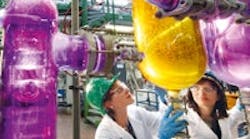To curtail global warming, governments around the world likely will clamp down harder on carbon dioxide release into the atmosphere. Researchers are grooming numerous technologies to capture CO2 from waste streams (e.g., see "Liquids Ease Acid-Gas Removal," "Researchers Target CO2 Capture," and "Polymer Promises Better CO2 Removal." However, capturing the gas represents only the first part of any solution — there's still a need to deal with the CO2. Sequestration and storage may play some role but don't diminish the amount of material. In contrast, using CO2 as a feedstock would consume the gas, save conventional raw materials and perhaps fossil fuels, and offer an economic benefit.
Researchers in Germany now are preparing to pilot a catalytic process in which CO2 is used as a reactant to produce polyether polycarbonate polyols (PPPs), a feedstock for making polyurethanes.
Bayer MaterialScience and Bayer Technology Services, both of Leverkusen, RWE Power, Essen, and RWTH Aachen University, Aachen, are working together on the effort. The German Federal Ministry of Education and Research (BMBF) will invest more than €4.5 million ($5.7 million) over the next three years in the project to move work from the laboratory to pilot scale.
The initiative is dubbed the "Dream Production" project because the reactions only have occurred at laboratory scale and so industrial use remains a "dream."
Construction of the pilot plant at Chempark Leverkusen already is underway and should be completed by the end of this year. It will enable kilogram-scale production of PPPs. Feedstock CO2 will come from RWE Power's lignite-fired power station at Niederaussen. For the Dream Production project, that plant's flue-gas scrubber will be equipped with a liquefaction system to ease transporting CO2 to Leverkusen; the system will have flexibility to provide from kilograms to metric tons of CO2 at various pressures and purities.
"Using the waste product CO2 to manufacture versatile materials is an amazing achievement made possible by catalysis," says Patrick Thomas, ceo of Bayer MaterialScience. "What's more, as an ultra-efficient organic insulating material, polyurethanes save around 80 times more energy during their service life than is required for their production. This ensures that PPPs have a doubly positive effect on climate protection."
Dream Production builds upon an earlier project called "Dream Reactions," initiated by Bayer and funded by BMBF. "As part of this project, we dealt with fundamental questions focusing on harnessing CO2 by using newly developed catalysts. We have achieved promising results that form the basis for industrial implementation in the Dream Production project," notes Dr. Dirk Van Meirvenne, managing director of Bayer Technology Services.
"The rewarding collaboration with Bayer MaterialScience and Bayer Technology Services as part of the CAT Catalytic Center (Figure 1) laid the foundations for this consortium," adds Prof. Walter Lietner, executive director of the Institute of Technical and Macromolecular Chemistry at RWTH Aachen University. "Unifying the entire value chain from the source to the product in one single project is unique in CO2 usage."
Bayer Corp. is a CP 50 company.